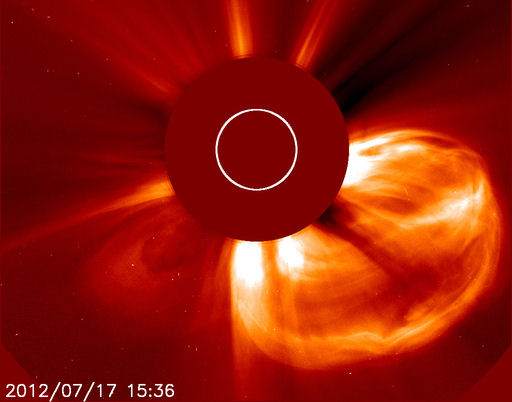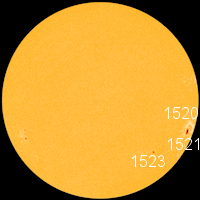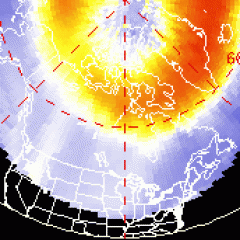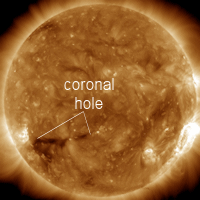~Space Weather Update~ Slow Explosion~ Will Reach Earth [1]
SLOW EXPLOSION: Sunspot complex AR1520-1521 erupted on July 17th, producing an M1-class [2] flare that unfolded slowly over a period of hours. Slow explosions often produce CMEs, and this one was no exception. Click on the image to view a movie of the bright, massive cloud recorded by the Solar and Heliospheric Observatory:
According to a forecast track [4] prepared by analysts at the Goddard Space Weather Lab, the CME will hit Venus on July 19th and could deliver a glancing blow to Earth on July 20th. The impact could re-energize but not rival the spectacular light show [5] of July 14th through 16th. Aurora alerts: text [6], voice [7].


![]()
Solar wind
speed: 453.5 km/sec
density: 0.6 protons/cm3
explanation [8] | more data [9]
Updated: Today at 1419 UT
![]()
X-ray Solar Flares
6-hr max: B9 1027 UT Jul18
24-hr: C3 0309 UT Jul18
explanation [10] | more data [11]
Updated: Today at: 1400 UT
![]()
![]()
![]()
Daily Sun: 18 Jul 12
![]()
![]()
Sunspot 1520 poses a threat for M-class [2] solar flares. As the sunspot turns away from Earth, however, the chances of a geoeffective eruption are decreasing. Credit: SDO/HMI
![]()
![]()
![]()
Sunspot number: 87
What is the sunspot number? [13]
Updated 17 Jul 2012
Spotless Days
Current Stretch: 0 days
2012 total: 0 days (0%)
2011 total: 2 days (<1%)
2010 total: 51 days (14%)
2009 total: 260 days (71%)
Since 2004: 821 days
Typical Solar Min: 486 days
Updated 17 Jul 2012
The Radio Sun
10.7 cm flux: 138 sfu
explanation [14] | more data [15]
Updated 17 Jul 2012
![]()
![]()
![]()
Current Auroral Oval:
![]()
Switch to: Europe, USA, New Zealand, Antarctica
Credit: NOAA/POES
![]()
![]()
![]()
Planetary K-index
Now: Kp= 1 quiet
24-hr max: Kp= 3 quiet
explanation [17] | more data [18]
![]()
Interplanetary Mag. Field
Btotal: 5.3 nT
Bz: 2.2 nT north
explanation [19] | more data [20]
Updated: Today at 1426 UT
![]()
![]()
![]()
Coronal Holes: 18 Jul 12
![]()
![]()
A solar wind stream flowing from this coronal hole should reach Earth on or about July 21st. Credit: SDO/AIA.



